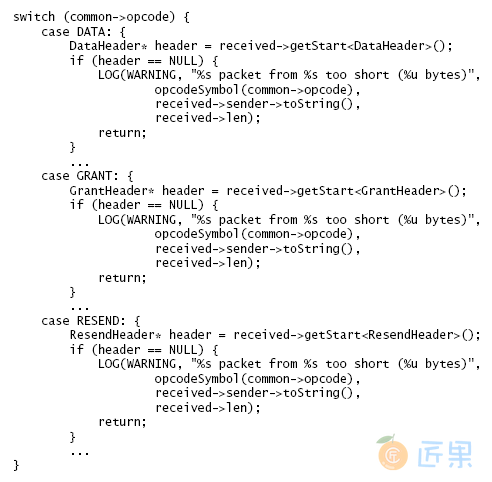如果模块包含可用于多种不同目的的机制,则它应仅提供一种通用机制。它不应包含专门针对特定用途的机制的代码,也不应包含其他通用机制。与通用机制关联的专用代码通常应放在不同的模块中(通常是与特定用途关联的模块)。 第六章:通用模块更深入 中的 GUI 编辑器讨论阐明了这一原理:最佳设计是文本类提供通用文本操作,而特定于用户界面的操作(例如删除所选内容)则在用户界面模块中实现。
如果相同的代码(或几乎相同的代码)一遍又一遍地出现,那是一个危险信号,您没有找到正确的抽象。
图 9.1:此代码处理不同类型的传入网络数据包。对于每种类型,如果数据包对于该类型而言太短,则会记录一条消息。在此版本的代码中,LOG 语句对于几种不同的数据包类型是重复的。
图 9.2:对图 9.1 中的代码进行了重新组织,因此只有 LOG 语句的一个副本。
通常,系统的下层倾向于更通用,而上层则更专用。例如,应用程序的最顶层包含完全特定于该应用程序的功能。将专用代码与通用代码分开的方法是将专用代码向上拉到较高的层,而将较低的层保留为通用。当您遇到同时包含通用功能和专用功能的同一类的类时,请查看该类是否可以分为两个类,一个包含通用功能,另一个在其上分层以提供特殊功能。
If a module contains a mechanism that can be used for several different purposes, then it should provide just that one general-purpose mechanism. It should not include code that specializes the mechanism for a particular use, nor should it contain other general-purpose mechanisms. Special-purpose code associated with a general-purpose mechanism should normally go in a different module (typically one associated with the particular purpose). The GUI editor discussion in Chapter 6 illustrated this principle: the best design was one where the text class provided general-purpose text operations, while operations particular to the user interface (such as deleting the selection) were implemented in the user interface module. This approach eliminated information leakage and additional interfaces that were present in an earlier design where the specialized user interface operations were implemented in the text class.
If the same piece of code (or code that is almost the same) appears over and over again, that’s a red flag that you haven’t found the right abstractions.
Figure 9.1: This code processes incoming network packets of different types; for each type, if the packet is too short for that type, a message gets logged. In this version of the code, the LOG statement is duplicated for several different packet types.
Figure 9.2: A reorganization of the code from Figure 9.1 so that there is only one copy of the LOG statement.
In general, the lower layers of a system tend to be more general-purpose and the upper layers more special-purpose. For example, the topmost layer of an application consists of features totally specific to that application. The way to separate special-purpose code from general-purpose code is to pull the special-purpose code upwards, into the higher layers, leaving the lower layers general-purpose. When you encounter a class that includes both general-purpose and special-purpose features for the same abstraction, see if the class can be separated into two classes, one containing the general-purpose features, and the other layered on top of it to provide the special-purpose features.

